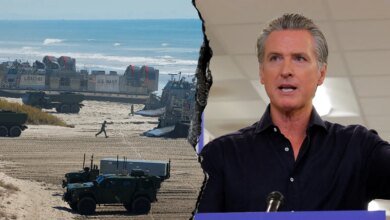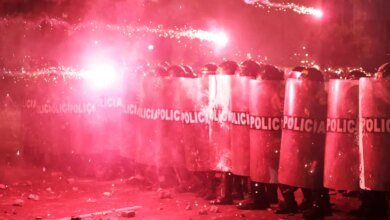Trump Should Resist Putin’s Push to Extend the New START Treaty

Last month, Russian President Vladimir Putin proposed extending the terms of the New Strategic Arms Reduction Treaty (New START) by one year. On October 5, US President Donald Trump said this “sounds like a good idea.”
But it’s a bad idea. The United States needs to expand its nuclear force to deal with the growing nuclear threat from China, and it should not be constrained by an outdated arms control agreement with the superpower that was concluded yesterday.
Last month, Russian President Vladimir Putin proposed extending the terms of the New Strategic Arms Reduction Treaty (New START) by one year. On October 5, US President Donald Trump said this “sounds like a good idea.”
But it’s a bad idea. The United States needs to expand its nuclear force to deal with the growing nuclear threat from China, and it should not be constrained by an outdated arms control agreement with the superpower that was concluded yesterday.
Since the 1972 Strategic Arms Limitation Treaty (SALT I), Washington and Moscow have negotiated the limits of their strategic nuclear forces. New START is the most recent agreement; It was signed in 2010 and limits each side to no more than 1,550 deployed strategic nuclear warheads. It is scheduled to expire in February 2026.
Over the past decades, arms control has been an important component of US strategic nuclear policy. Arms control agreements have contained the nuclear arms race, provided transparency regarding Russia’s nuclear forces, and helped stabilize often-turbulent bilateral relations. It also enabled political support for US nuclear modernization. There is bipartisan consensus on an approach that supports strong deterrence and strong arms control.
But there were always problems. The New START treaty limits Russia’s so-called strategic forces, such as high-yield nuclear weapons on intercontinental ballistic missiles and bombers, but leaves Russia’s lower-yield weapons on the battlefield untouched. This gives Russia a 10-1 advantage over the United States and NATO in non-strategic nuclear forces. Republican senators approved the New START Treaty in 2010 on the condition that the imbalance of non-strategic powers be addressed, but no progress has been made on this front.
In addition, Russia has cheated on almost every arms control agreement it has signed, including the New START Treaty. On-site inspections were suspended during the COVID-19 pandemic, and Russia subsequently refused to allow them to resume, leading Washington to declare in 2023 that Moscow was in violation of the treaty. In February of that year, Putin announced that he would suspend Russia’s participation in the treaty but would voluntarily adhere to the treaty’s numerical limits. The United States took countermeasures, stopping participation in verification protocols, such as data sharing, but announcing that it would also continue to adhere to digital borders.
In short, Project New START is already on life support.
But the most important problem with New START is China’s rapid nuclear buildup. When the treaty was signed, China possessed a few hundred nuclear weapons. American strategists estimated that 1,550 nuclear weapons were enough to deter Russia and also deal with China’s much smaller arsenal.
However, since 2021, China has engaged in the world’s fastest nuclear expansion since the 1960s. It is expected to have 1,500 nuclear weapons by 2035, which is close to the limits of the New START Treaty, and there is no guarantee that it will stop there.
This means that, for the first time in history, the United States will need to deal with two near-peer nuclear superpowers.
The US congress appointed me and eleven other experts to a bipartisan commission to study this problem. In 2023, we unanimously concluded that current and planned U.S. nuclear forces will be insufficient to deal with this rapidly evolving threat.
The international security environment has deteriorated significantly since the signing of the New START Treaty. US nuclear force sufficient for 2010 will not be sufficient to confront the more dangerous world the United States faces in 2025 and beyond.
For the first time since the end of the Cold War, the United States will need to expand its nuclear forces.
Contrary to what many students learn about the theory of nuclear deterrence and mutually assured destruction, the United States does not plan to specifically target innocent civilians to make a nuclear war unwinnable. Instead, Washington has long practiced what some refer to as counterforce targeting. In other words, US nuclear plans prioritize legitimate military targets, such as command, military forces, nuclear forces, and war-supporting industry.
There are many reasons for this, but most importantly, this is the most effective factor in deterring the country’s authoritarian opponents. Putin and Chinese President Xi Jinping do not care about the well-being of their citizens as much as they care about their lives, their regimes, and their armies. Thus, the US nuclear strategy threatens to jeopardize what its opponents value more than anything else.
For this reason, China’s nuclear buildup is putting upward pressure on the size of America’s nuclear force. While China is building hundreds of new nuclear missile silos, it is also creating hundreds of new targets that the United States must compromise as part of its deterrence strategy. This will require more weapons.
In theory, Washington could try to stop China’s nuclear buildup through trilateral arms control negotiations, but Beijing refuses to talk. Xi is committed to a larger nuclear arsenal and is not willing to give it up.
In this context, bilateral arms control with Russia, such as pursuing the New START Treaty, no longer makes sense. The United States should not lock itself into a deal with Russia while its archrival, China, builds its forces.
Critics argue that expanding US nuclear forces would prompt Russia and China to build their own nuclear weapons in response, which would lead to a new arms race. Maybe you will. Maybe it won’t happen. But this is a secondary consideration. The primary goal of US nuclear strategy is not to avoid an arms race.
The primary purpose of American nuclear weapons is to deter nuclear war, and given China’s rapid military buildup, the United States will soon lack effective deterrence. You must get this right first.
Accordingly, our committee recommended that the United States urgently prepare to load additional nuclear warheads on the nation’s strategic launchers, plan to purchase additional nuclear-capable bombers and submarines, and develop and deploy additional nonstrategic nuclear weapons in both Europe and Asia.
The Biden administration has acted on many of our recommendations and has made necessary preparations to load additional warheads on U.S. long-range missiles. The Trump administration must pursue and expand US nuclear forces when the New START Treaty expires in February.
Extending New START by one year would therefore be a mistake. It will prevent the United States from taking the necessary steps to deter China and Russia. These are steps that should not be postponed. Our report used the word “urgent” 40 times.
By offering to extend New START, Putin does not have the interests of the United States at heart. He does not want to see the United States strengthen its nuclear deterrent, and he is trying to thwart that.
Trump should not play along.
US nuclear forces have contributed to international peace and stability for 80 years. Washington must move forward in building the strategic forces the United States needs to protect itself and its allies.
Don’t miss more hot News like this! Click here to discover the latest in Politics news!
2025-10-16 15:42:00




